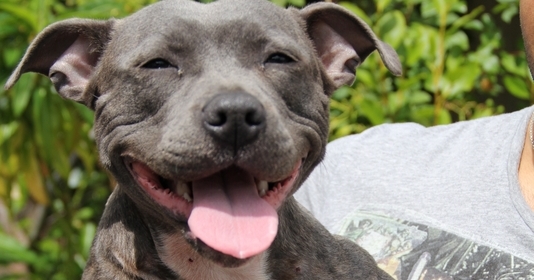
Skye first developed itchy skin on the underside of her neck when she was just six months old. There was no obvious cause of the problem: she began to itch her throat with her back legs for no particular reason. Within a couple of days, the skin in the area was red and sore, and she continued to scratch at it, making it even worse.
Darren took her to his vet in Scotland and skin scrapings were taken to check for parasites. The skin scrapes were negative, so it was presumed that she was sensitive to something in her immediate environment. Darren was asked to stop using chemicals in his home such as floor cleaners or detergents used to wash her bedding. He started to wash the floor in just hot water, and gave her just bland brown paper to sleep on. At first this seemed to work, and the rash settled down, but a few weeks later, it flared up again. His vet then advised him to apply a protective, moisturising cream. This seemed to help, but from time to time, the itchy skin recurred.
Last week, when Darren was visiting his family in Bray, the itch came back, and it was worse than ever. The entire underside of her throat, from her chin all the way back to her abdomen, turned bright red, as if she’d been stung by wasps. Darren brought her in to see me, and I decided that we needed to move to the next stage of investigating the problem.
Skye was given a general anaesthetic, and a series of small skin biopsies were taken from the affected area and sent off to the laboratory for analysis. There are many rare skin diseases that can only be diagnosed in this way, and it was important to rule them out.
The laboratory report arrived a few days later. When examined under a microscope, using special dyes, it had been possible to work out precisely what was going wrong with Skye’s skin. There was no strange or complex disease going on here: the biopsies confirmed that she was suffering from an allergic-type reaction, most likely to something that she was coming into contact with. Skye is a dog with hyper-sensitive skin, just like some humans. It’s likely that she’s allergic to many different substances, including household chemicals, fabrics and floor surfaces, as well as grasses and pollens outdoors.
What next? It would be possible to do more analysis of her allergies, doing skin or blood tests to identify the substances that cause the biggest reaction, and she could then be given specific desensitising treatment. The difficulty with this approach is that she could be allergic to so many different substances that it could be difficult to include enough of them.
A simpler alternative was to equip Darren with an anti-inflammatory spray. If Skye’s skin flares up, a few squirts of the spray are enough to rapidly calm it down. At the same time, Darren is learning about what’s most likely to set her off, so he can avoid certain floor surfaces or types of vegetation.
Skye will always have sensitive skin, but there are simple ways that Darren can manage her problem so that it never gets so red and sore that it bothers her.
Tips
- Itchy skin is one of the most common reasons for dogs being taken to the vet
- Sometimes simple general treatment may be enough to solve the problem
- If the itchiness recurs repeatedly, a full investigation, including biopsies, is often needed




Please note that I am unable to answer veterinary questions in comments. If you have questions or concerns about your pet's health it is always better to contact your vet.